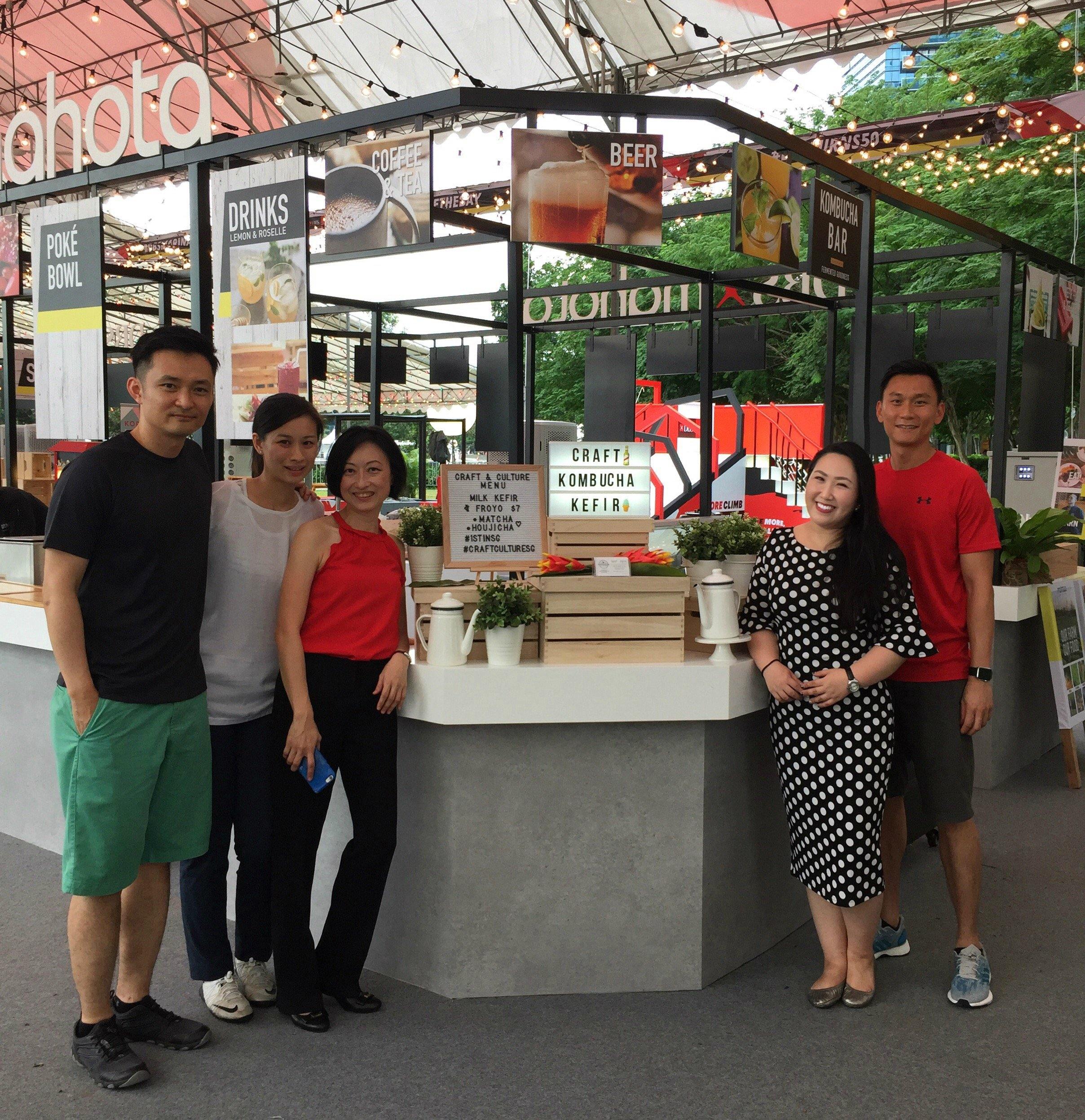What is Kombucha? And why is it taking Singapore and the World by Storm?
Posted on
Kombucha (or booch) is a naturally fermented tea drink, with a slight vinegary taste.
When left to ferment in bottles for extended time, it becomes carbonated and fizzy. It contains B-vitamins, enzymes and a high concentration of gluconic, acetic and lactic acids, as well as a number of other metabolites like glucosamine!
As a result of the acetic fermentation process, unflavoured kombucha contains trace amounts of alcohol which generally measure anywhere between .03 – 0.1% (similar to an overripe fruit).
What is the history of kombucha?
The history of kombucha starts with records of its consumption in China, 221 B.C. It was highly esteemed for its healing properties and was even called the ‘Elixir of life.’ Legends say that there was a doctor named Kombu who brought this fungus to Japan in order to heal a Japanese emperor.
According to the story, the emperor was healed and the fermented tea drink was thereafter named Kombu-cha. Cha is the Japanese word for tea. Other accounts report that it is named after Japanese seaweed called kombu, because the kombucha mushroom lives on water.
Regardless of whether these stories are true, the drink became exceedingly popular in Japan. In the 19th century, this tea drink was widely consumed in Russia. In the 1920s, the first studies about kombucha were published in Russia. After World War II, kombucha's popularity dipped, due to lack of sugar and other ingredients which are necessary to nurture kombucha.
In various countries around the world, kombucha is consumed. However, it takes on many names, such as: Saudi Arabia: Al Nabtah Japan: Kocha Kinoko (red tea mushroom or fungus) China: Hong Cha Jun 红茶菌 or Hong Cha Gu 红茶菇 (red tea mushroom or fungus) Taiwan: Haipao Germany: Hongo
What are the health benefits?
Kombucha has been consumed as a health beverage in many countries, for centuries. It has gone through periods of popularity, such as in the 1970’s, 90’s and it has made a comeback in the recent years..
Kombucha’s popularity is mostly attributed to the beneficial living organisms it contains. In addition, it offers a tasty and healthier alternative to other sugary soft drinks on the market.
Scientific studies, support beneficial claims that kombucha increases antimicrobial activity, reduces cholesterol levels, reduces atherosclerosis by regenerating cell walls, reduces blood pressure, reduces inflammatory problems, promotes better liver function by removing toxins, aids digestion, Alkalize’s our body’s internal pH levels and increases our energy levels.
What types of teas are used in kombucha?
Any caffeinated green or black tea can be used to brew kombucha. Craft & Culture uses organic black tea. However, teas that won’t work in kombucha brewing include the following:
- Decaffeinated green or decaffeinated black tea
- Earl grey tea (as it contains bergamot oil)
- Other herbal teas as they may contain antibacterial properties, which work against the beneficial bacterias and yeasts.
For decaffeinated kombucha, we also use rooibos tea or hibiscus tea (made to order). Please note, that using rooibos/hibiscus tea will not produce a fizzy kombucha brew.
What about caffeine in kombucha?
The fermentation process will not fully remove the caffeine content from the kombucha brew. However, it will reduce the original caffeine content, so that it will not be as strong as a cup of normally brewed tea. Typically, literature suggests that one-third of the caffeine content is left after fermentation.
Kombucha is safe for the consumption of children above the age of 1. Temperature, air quality, water quality, ingredients and the amount of starter culture used play a big part in any fermentation. As a result, each ferment will always vary, from batch to batch. This particularly applies when seasonal temperatures change. Kombucha will always brew quicker in warmer temperatures, and take longer in cooler climates and environments.
What happens if kombucha is left alone for a long time?
Aged kombucha is extremely sour, like vinegar. If you do happen to turn your kombucha into vinegar, do not throw it out. Simply keep some of it to use as as non toxic cleaners or diluted as a face mask.
Kombucha pH Levels?
Kombucha has a pH level of around 3.5 or lower (2.5), this low pH range creates a vinegar which results in a highly acidic environment, that inhibits mold and other pathogens but allows the bacteria and yeast strains found in kombucha to thrive.
The sweeter the kombucha, the higher the pH; the the lower the pH, the tarter the taste. Please note: pH levels will never fully determine if the kombucha brew is ready.
Is kombucha probiotic?
There is currently a lot of speculation on whether kombucha is a prebiotic or probiotic. This topic is still relatively new to the researchers, therefore knowledge on kombucha is still in its infancy stage. Probiotic bacteria is most often derived from Lactobacillus or Bifidobacterium. Lactobacillus has been identified in the SCOBY, and isolated in the kombucha liquid in several studies.
However, there are a few common probiotic yeast strains, such as Saccharomyces boulardii which used to be identified separately from S. cerevisiae, However, due to their similarities, it has now been classified as a strain of S.cerevisiae which is predominantly identified in kombucha’s liquid and the kombucha SCOBY.
Whilst the strains in every batch of kombucha vary, Saccharomyces boulardii/ cerevisiae is one of the undisputed yeast strains that are found abundantly in kombucha and is probiotic in nature. So, we will leave it to you to decide, and science to prove the theory in the future either way.
What bacteria and yeasts make up kombucha?
Microbial profiles of kombucha from various origins differ significantly. This means that home brewed kombucha may or may not contain any, or all of the strains mentioned below.
Every batch of kombucha is unique and is made up of a living colony of bacteria and yeasts based on its surrounding environment. Fermentation is not something that can be standardized. The acidic and vinegary nature of kombucha, provides a natural environment that protects it from any harmful pathogens.
We have put together a list of strains that you may find in kombucha. The findings are derived from published scientific papers. This list is not exhaustive and cannot be relied upon exclusively. The information does not constitute as medical advice in any way.
Kombucha isolated Yeasts
- Schizosaccharomyces pombe (Mayser et al. 1995; Teoh, Heard & Cox 2004; Tietze 1996; Wang et al. 2014)
- Saccharomycodes ludwigi (Mayser et al. 1995; Tietze 1996; Wang et al. 2014)
- Pichia fermentans Schizosaccharomyces pombe (Tietze 1996) Pichia fermentans (Marsh et al. 2014; Mayser et al. 1995)
- Pichia membranaefaciens (Mayser et al. 1995)
- Hyphopichia burtonii (Mayser et al. 1995) Mycoderma (Mayser et al. 1995)
- Brettanomyces bruxellensis (Teoh, Heard & Cox 2004; Wang et al. 2014)
- Zygosaccharomyces bailii (Mayser et al. 1995; Teoh, Heard & Cox 2004; Wang et al. 2014)
- Zygosaccharomyces kombuchaensis (Wang et al. 2014)
- Candida Kefyr (Mayser et al. 1995; Ramadani & Abulreesh 2010)
- Candida krusei (Mayser et al. 1995; Ramadani & Abulreesh 2010; Wang et al. 2014)
- Candida stellata (Teoh, Heard & Cox 2004)
- Candida colleculosa (Ramadani & Abulreesh 2010)
- Candida Tropicalis (Wang et al. 2014) Candida guilliermondii (Ramadani & Abulreesh 2010)
- Kloeckera apiculata (Mayser et al. 1995; Wang et al. 2014)
- Hanseniaspora (Mayser et al. 1995)
- Saccharomycodes ludwigi (Wang et al. 2014)
- Saccharomyces cerevisiae (Mayser et al. 1995; Wang et al. 2014) Saccharomycodes inconspicus (Wang et al. 2014)
- Torulaspora delbrueckii (Teoh, Heard & Cox 2004)
- Debaryomyces hansenii (Wang et al. 2014)
Acetic Acid
- Acetobacter xylinum (Wang et al. 2014)
- Acetobacter xylinoides (Wang et al. 2014)
- Bacterium gluconicum (Wang et al. 2014)
- Acetobacter suboxydans (Wang et al. 2014)
- Gluconobacter liquefaciens (Wang et al. 2014)
- Acetobacter aceti (Steinkraus et al. 1996; Wang et al. 2014)
- Acetobacter pasteurianus (Liu et al. 1996; Wang et al. 2014)
Lactic Acid Bacteria
- Lactobacillus bulgaricus (Wang et al. 2014)




